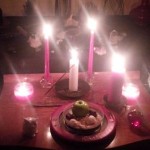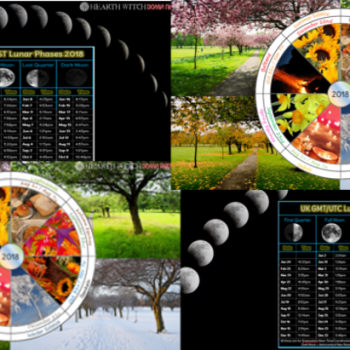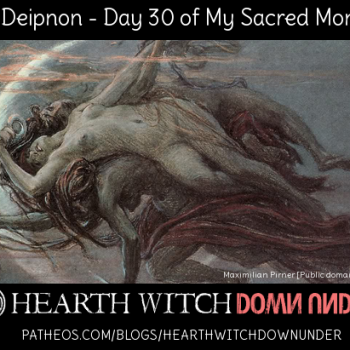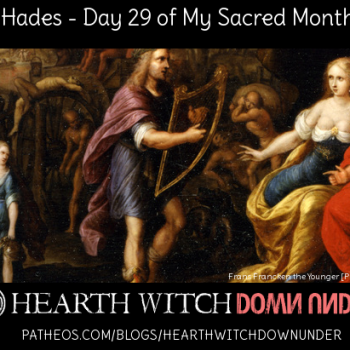This post is part of a blog challenge series, 30 Days of Devotion to Hekate. We’re up to day 12 and looking at places associated with Hekate and Her worship.
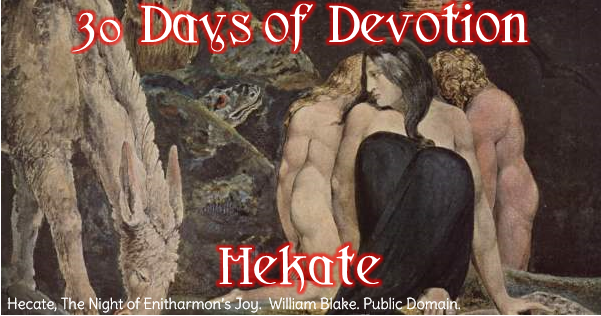
I am finding this to be one of the more difficult topics to tackle for Hekate. It’s a sad fact that, other than a few fragments in various texts and a few broken altars and temples – we actually know very little about the cults of Hekate in ancient times. We know a bit about how She was worshipped in a more general manner throughout Hellas, but we don’t have a lot of information about specific cultus worship beyond tidbits.
Ancient Places
Samothrace
Samothrace was home to a great temple complex for the Cult of the Great Gods, and Hekate was among those worshipped there, under the name of Zerynthia. It was also home to a great mystery cult which, unlike the Eleusinian Mysteries, was open to any and all people.
The Zerinithian Cave on Samothrace is where She was said to have received dogs in sacrifice. She is mentioned multiple times in regards to Samothrace, especially in reference to torches and torchbearers – “torchbearing mystics of the Maid”.
Sadly we don’t know a whole lot about the cult, being a Mystery Cult, even if an open one, does make it, well, a mystery. What we do know is that Hekate had a part in this Mystery.
Thessaly
She was worshipped in Pherae in Thessaly as Hekate Brimo. It was here, by the lake Boebis that She lay with Hermes. And I am sure we’ve all heard of the Thessalian Witches. Medea, the Priestess and maybe daughter of Hekate has ties to Thessaly, and like the Thessalian witches is said to have been able to draw down the moon. The Thessalian witch, Erictho, in a play by Lucan, not only referenced Persephone as being a lesser version/aspect of Hekate, but also referred to Hekate as “our Hekate”.
Lagina
Lagina, in Caria, is one of the places suspected of being the origin of Hekate. She had a great temple there, the remnants of which are still there today and you can see below in the photo. This temple drew in some pretty great festivals – during these festivals they would carry the key from nearby Stratonicea to the temple in procession. She was served in this temple by eunuchs. It should be noted that She is said to be the patron Goddess of nearby Stratonicea.

Colchis
Colchis is not necessarily entirely historical in it’s connection to Hekate, but more mythical. The 1st century BCE historian, Diodorus Siculus identified Hekate as being married to Aeetes, King of Colchis and from this union they bore Medea and Circe. In other myths, Hekate is said to have had a temple in Colchis with a fairly magnificent garden, which is where we get a lot of our ideas on Hekates sacred plants (poisons).
However, this garden and this particular part of the myth is not necessarily as historical as it seemed. The Argonautica Orphica is a text that was thought to have been written long before it actually was, which we now know was probably around the 5th or 6th centuries CE. Either way, Medea is a daughter of the King of Colchis and she was a priestess of Hekate, if not a daughter, and thus Hekate was connected to Colchis in myth. Though perhaps not history.
General Places
Though we don’t know a whole lot about Her cultus in specific places in ancient Hellas, we do know She had other generalised places that were sacred to Her. Of course we have discussed some of these already throughout the series – and probably will again in the upcoming posts – so I won’t go too far into discussing them.
Crossroads
Hekate is the Goddess of the Crossroads. There were statues of Her triple form at many crossroads, and it is tradition to leave offerings to Her at the crossroads.
Cemeteries
As the leader of the dead, an Underworld Goddess and a liminal Goddess, of course cemeteries are consider sacred places in Her cultus. In the offerings post it is even SPG that cemetery (graveyard) dirt is an offering to Her. It is also a handy ingredient in Witchcraft, which is Hekates province as well.
Caves
Caves are considered liminal places and entrances to the Underworld. As we can see above, in Samothrace, there was a specific cave that was part of Her worship and sacrifices were made to Her there. In the Rape of Persephone myth, Hekate was in Her cave when She heard Kores cries during the abduction.
Waters Edge
The shore at the beach or river banks, shore of lakes and the like are also considered sacred to Hekate. Doesn’t seem so obvious until you really think about it, but these are liminal areas as well – they are the places where earth, ocean and even sky connect together in their own kind of crossroad. Since Hekate is a Crossroads and Liminal Goddess, and She is Ouranic, Chthonic and Oceanic, this cross point would indeed be meaningful in Her cultus. But this is, perhaps, more of a modern SPG idea.
Entrances
As the One Before the Gates, of course gateways are an area of Hekates influence. Similar areas, such as doorways, also are included. In Athens it was common for houses to have a Hekatesion, a small shrine to Hekate, just outside the door, it was apotropaic (protective/evil averting) and served as a place to leave Deipnon offerings.
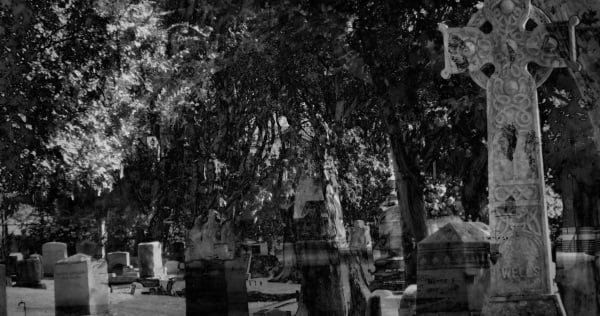
30 Days of Deity Devotion
1 – A basic introduction of the deity
2 – How did you become first aware of this deity?
3 – Symbols and icons of this deity
4 – A favourite myth or myths of this deity
5 – Members of the family – genealogical connections
6 – Other related deities and entities associated with this deity
7 – Names and epithets
8 – Variations on this deity (aspects, regional forms, etc.)
9 & 27 – Common mistakes and worst misconceptions about this deity
10 – Offerings – historical and UPG
11 – Festivals, days, and times sacred to this deity
12 – Places associated with this deity and their worship
13 – What modern cultural issues are closest to this deity’s heart?
14 – Has worship of this deity changed in modern times?
15 – Any mundane practices that are associated with this deity?
16 – How do you think this deity represents the values of their pantheon and cultural origins?
17 – How does this deity relate to other gods and other pantheons?
18 – How does this deity stand in terms of gender and sexuality? (historical and/or UPG)
19 – What quality or qualities of this god do you most admire? And find the most troubling?
20 & 21 – Art and music that reminds you of this deity
22 – A quote, a poem, or piece of writing that you think this deity resonates strongly with
23 – Your own composition – a piece of writing about or for this deity
24 & 25 – A time when this deity has helped you, and refused to help
26 – How has your relationship with this deity changed over time?
28 – Something you wish you knew about this deity but don’t currently
29 – Any interesting or unusual UPG to share?
30 – Any suggestions for others just starting to learn about this deity?

